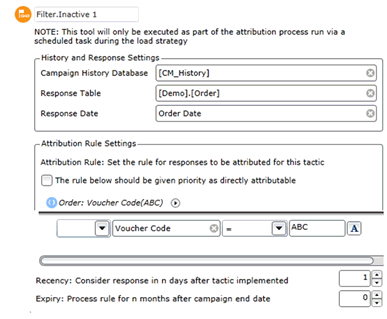
The Response Attribution tool allows you to configure appropriate response rules to monitor the success of a specific campaign and creative. The tool is processed on a nightly basis via iLoader, and therefore allows you to track from the people who were contacted as part of the campaign, how many of them responded, through to the number of people who placed an order after responding to the campaign.
An attribution level captures the events on a campaign. For example seeing how many orders were placed as part of the campaign.
Using the Response Attribution Tool
The Response Attribution tool allows you to apply one or more attributions to a creative.
Select the Events tab on the creative.
Drag the Response Attribution tool onto the creative.
Select the Campaign History database. Please note this is a mandatory field.
This is the database when iLoader stores your history data.
Select the Response table. Please note this is a mandatory field.
This is the Engine table that corresponds to the attribution level, for example Orders. Multiple response tables can be used within a single tactic.
Enter the Response Date. Please note this is a mandatory field.
This is the column that supplies the information for calculating recency, for example Order Date.
Set any attribution rule settings if required. For example:
Check 'The rule below should be given priority as directly attributable' checkbox to process the rule below any other attribution rules.
Select the relevant query selection that is to be applied to the rule, for example a column from the Data Explorer and place it in the Filter area. Please note the use of variables is not supported.
Apply the rule criteria
Note: The attribution rule is run against the attribution table to reduce all data to those responses to be considered for attribution. For example Voucher Code ='ABC'
Enter the Recency value.
This is the number of days between the response day and the Tactic Instance Date, being the date and time the tactic was sent. For example:
0: Up to midnight on the same day
1: Up to midnight the next day
Enter an Expiry value.
This is the number of months after campaign completion that attribution will continue to run. For example:
0: Attribution stops at the campaign end date or cancelled campaign date.
1: Attribution stops 1 month after the end date of the campaign, or the last day of the next month if the corresponding date does not exist. For example an end date of 31st Jan would continue processing to 28th Feb, as it works on a calendar basis.

The tool is executed via an iLoader command, which will parse all instances of the tool and order initially as Direct against Non Direct, then in recency of event. The campaign tool completes the following tasks:
Process Rule: To produce a domain on the response table representing rows to be considered for attribution. This will automatically consider recipients of the creative.
Link the response back to the campaign it has been attributed to.
The Response Attribution tool is processed as part of the nightly load strategy against the standard Engine repository. Please see the Best Practice for Loading and Maintenance guide for further information.
As this tool runs against an attribution level table it will mark each relevant response with a History key to allow the link between this response and the History table. This means that each response can only be attributed to a single campaign. There is the opportunity to mark rules as direct or in-direct (implied), and with the recency processing this should allow high confidence that the response has been attributed to the correct campaign.
| Name | Description |
| Attribution | The ability to associate an event such as a purchase or call centre enquiry, to have been made as part of campaign activity. |
| Responder | A customer, either known or unknown who made a response that has been captured as potentially having been triggered by a piece of Campaign activity. The response will have occurred within a defined time period after campaign deployment. |
| Indirect/ Implied Responses | The responders action is the result of contact made by a campaign. The responders must have been mailed by the campaign and have responded in the appropriate timescales. |
| Indirect Unknown | A response that does not have a cell code, or match to any known individual. |
| Double Counting | For indirect/implied responses there is a potential for a response to be attributable to more than one campaign or even two tactics in the same campaign if the campaign activities overlap and therefore based on the rules, that response could be counted twice. The SDL Attribution Engine has a direct rule that will only attribute one response to one campaign, meaning that double counting will not occur. |